Archive for the 'Information organisation' Category
July 16th, 2011 by thapke
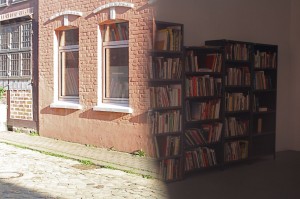 In the end of June 2011 my attention was called to a talk with the title "Unpacking a library" which was given by an art historian Magnus Schäfer from Berlin on the oocasion of an exhibition titled "Dealing with – some books, viusals, and works related to the American Fine Arts, Co." which took place in Lüneburg in the small "Halle für Kunst (Hall of Art) Lüneburg" accompanied by the Kunstraum of the Leuphana University in Lüneburg. The photo with the view on the library was taken from outside the "Halle der Kunst" when looking through the window from the Baumstraße, one of Lüneburg’s beautiful, old streets! The Baumstraße itself is an artwork containing the so-called "Steinmeile" (Mile of Stones).
In the end of June 2011 my attention was called to a talk with the title "Unpacking a library" which was given by an art historian Magnus Schäfer from Berlin on the oocasion of an exhibition titled "Dealing with – some books, viusals, and works related to the American Fine Arts, Co." which took place in Lüneburg in the small "Halle für Kunst (Hall of Art) Lüneburg" accompanied by the Kunstraum of the Leuphana University in Lüneburg. The photo with the view on the library was taken from outside the "Halle der Kunst" when looking through the window from the Baumstraße, one of Lüneburg’s beautiful, old streets! The Baumstraße itself is an artwork containing the so-called "Steinmeile" (Mile of Stones).
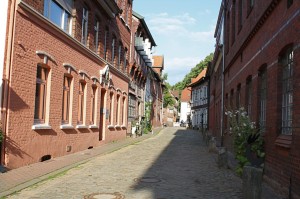
Before I knew nothing about the New York gallery American Fine Arts, Co. which was founded and headed by Colin de Land (1955-2003)! But I was attracted by the Walter Benjamin quote in the title of the talk. Through the talk and the visit of the exhibition I learnt that the library of the gallery has been transferred to Germany and was shown during the exhibiton. During the talk and the discussion afterwards interesting statements and questions have been raised:
- Has the collection/library lost its subject when the galery was closed after the dead of the founder?
- The statement "The library is a document" brought to my mind Michael Buckland’s papers "What is a document?" and "What is a ‘digital document’?"
- When is a collection of books called a library?
- The American Fine Arts library has also been used a little bit like a public library when artists borrowed books for their work.
- The library now, can it be viewed itself as a work of art, as an artifact?
- Can the library now be viewed as self-contained actant in the sense of Bruno Latour? (See also a post about Latour in my German blog)
- The smallest book in the library has been a little books about dogs, "Das kleine Hundebuch" from the publisher Heyne, which was shown during the talk.
More on the gallery American Fine Arts, Co. see here: "American Fine Arts – If culture means anything" curated by James Fuentes, essay by Jackie McAllister.
August 14th, 2008 by thapke
Just published: The Unimaginable Mathematics of Borges’ Library of Babel by William Goldbloom Bloch (Oxford University Press 2008). The Library of Babel has a lot to do with combinatorics. Jorge Luis Borges‘ essay was influenced by another one by the German Kurd Lasswitz, the father of modern “science fiction”: Die Universalbibliothek (The universal library).
See also Catarina Caetano da Rosa’s German paper with the title “Bibliotheken von Babel: Wunsch- und Albtraum des unendlichen Wissensraumes (Libraries of Babel: great dream and nightmare of the infinite knowledge space)” at the Workshop called “Architekturen der digitalen Weltbibliothek aus historischer und aktueller Perspektive (Architectures of the digital world library from a historical and actual view)” at a computer sciences conference in Germany in 2007 (37. Jahrestagung der Gesellschaft für Informatik (GI)).
July 8th, 2008 by thapke
The aesthetics of networks: A conceptual approach toward visualizing the composition of the Internet by M.K. Sterpka, in: First Monday, volume 12, number 9 (September 2007)
Hierarchy is an entrenched social concept. The Internet however, presents the possibility of envisioning social relations as a level or ‘flat’ configuration. The Internet fosters relationships that are networked, heterogeneous and horizontally distributed. This article contemplates the surface features of networked structures like the Internet by using topographic imagery.
May 13th, 2008 by thapke
Horst W. J. Rittel (1930 – 1990) was a German-born design theorist and university professor, educated as a theroretical physicist. He is best-known (along with M. Webber) for coining the term ‘wicked problem’, but his influence on design theory and practice was also much wider. In 1963 Rittel went to Berkeley. In 1973 he also joined the University of Stuttgart in Germany.
In his work he also thought about information systems and developed a planning/design method known as IBIS (Issue-Based Information System) for handling wicked problems. With his German colleague Werner Kunz Rittel also wrote a book on the foundation of information science in Germany (Werner Kunz and Horst Rittel, Die Informationswissenschaften: ihre Ansätze, Probleme, Methoden und ihr Ausbau in der Bundesrepublik Deutschland, München 1972).
A short biography about Horst Rittel in the publication “University of California: In Memoriam, 1992 : A publication of the Academic Senate, University of California, Information on this publication may be obtained by contacting the Academic Senate Office on any of the University of California campuses / David Krogh, Editor”
Werner Kunz and Horst W. J. Rittel, Issues as elements fo information systems. Working Paper No. 131
July 1970, reprinted May 1979, University of California, Berkeley
Chanpory Rith and Hugh Dubberly, ‘Why Horst W. J. Rittel Matters’, Design Issues 23 (2007)1, 72-91.
May 9th, 2008 by thapke
The importance to think about creativity in information and library science (1) led to considerations about how to develop information systems to support people in their creativity, e.g. in musics (2) or how the form of accessing information inluences the generation of ideas and creativity, here e.g. for managers (3).
- Petrowski, Mary Jane: Creativity research: Implications for teaching, learning and thinking, in:
Reference services review 28 (2000) 304-312
- Barry Eaglestone, Nigel Ford, Luy J. Brwon, Adrian Moore: Information systems and creativity : an emprical study, in: Journal of Documentation 63 (2007) 443-464
- Vandenbosch, B., Fay, S. and Saatçioglu, A.: “Where Ideas Come From: A Systemic View Of Inquiry,” in: Sprouts: Working Papers on Information Environments. Systems and Organizations, Volume 1 (2001) 2, 109-131.
May 9th, 2008 by thapke
Based on Auguste Comte, Ostwald developed within his philosophy of nature a “pyramid of science†in which a “science of order†(he called it also “Mathetik”) was the basis.
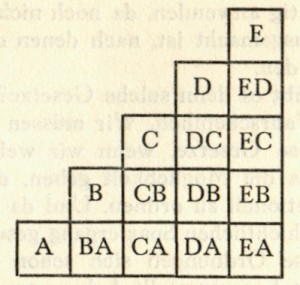
Ostwald ordered the sciences within a pyramid. When working on a new topic, e.g. the color theory, he combined the new topic with every layer of his pyramid in a combinatorical way to exhaust all aspect of this subject. So he developed first a basic theory of colors (e.g. EA in the picture), then viewed color theory from a physical (EB), chemical (EC), physiological or biological (ED) and psychological (E?!) view.
Ostwald planned and published a multi-vlolume work on color theory whose partial volumes in each case dealed with one of the views mentioned above. He founded a journal “Die Frabe” (The color), starting 1921, which used his monographic principle and ordered the single issues, which contain only one article, according his – as he called it – “Comte-Ostwaldian” system of concepts.
April 30th, 2008 by thapke
Niles R. Holt: “Wilhelm Ostwald’s ‘The Bridge'” (via Ralph Dumain: “The Autodidact Project”)
One of the lesser‑known projects of the German physical chemist Wilhelm Ostwald, a 1909 Nobel laureate and one of the last major scientific figures to oppose atomism, was the creation of an association for the ‘organization’ of science. … Among the plethora of ‘unity of science’ efforts that became prominent during the years preceding the First World War, the Bridge was distinctive for Ostwald’s emphasis on the ‘international organization’ of science as a means of furthering ‘scientific effiiciency’. [2] Although its tenure was short—from 1909 to 1914—the Bridge became the centre of a number of projects intended to promote ‘scientific efficiency’ through ‘organization’.
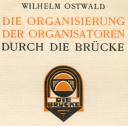
“The organization of organizers through the Bridge” – Title of a Bridge publication by Ostwald
From Energism, Ostwald claimed to have derived a ‘moral law of science’, the energetic imperative: ‘Do not waste energy, but transform it into a more useful form.’ [6] The ‘energetic imperative’ became, in turn, the basis for Ostwald’s stress on the ‘efficient organization’ of science. […] Ostwald, then, viewed the Bridge as a means of ‘organizing’, within the scientific community the ‘efficiency’ demanded by the ‘energetic imperative.’ All projects of the Bridge were to be ‘applications of the single fundamental idea of organization.’ [7] One project of the Bridge—a project to promote Esperanto as the exclusive language of international scientific conferences—resulted from Ostwald’s insistence that an auxiliary language would facilitate ‘more direct communication’ between scientists and eliminate the ‘energy waste’ involved in translations. Ostwald described still another project—the World Format—as an effort to ‘maximize the efficient use of energy’ by standardizing publication formats. The World Format was a standardized format for published scientific reports and abstracts; it even included specific dimensions for the size of paper on which reports were to be printed. Similarly, Ostwald believed that the Bridge would promote ‘efficiency’ in science by attempting to extend the metric system of weights and measures ‘into English speaking countries’.
From: Holt, Niles R. ‘Wilhelm Ostwald’s “The Bridge”’, British Journal for the History of Science, vol. 10, Part 2, no. 35, July 1977, pp. 146-150. See also: Niles R. Holt, A Note on Wilhelm Ostwald’s Energism, Isis, 61 (1970) 3, 386-389
March 30th, 2008 by thapke
Ostwald’s private library in Großbothen, Saxony – itself a symbol of harmony and order!
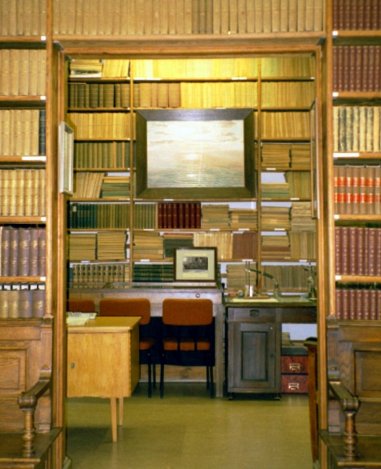
March 20th, 2008 by thapke
Today more and more connections between “in-formation”, education as well as advertising, art and design are visible in domains like information literacy, information design and knowledge media design.
One ‘hidden’ connection to information science is shown here: Horst Rittel, later professor of design in Berkeley, was a successor of Max Bense at the Ulm School for Design founded by Max Bill. Ostwald was mentioned by Bill in the afterword of the German edition of Kandinsky’s "Point and line to plane". Max Bense wrote books about philosophy of nature and aesthetic information, Rittel together with Werner Kunz a book on the foundation of information science in Germany.
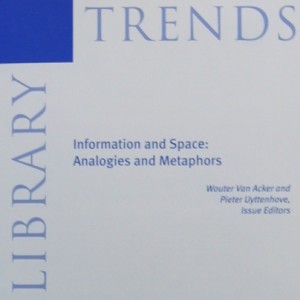 Five years after the “Analogous Spaces” conference its proceedings has been published with the title “Information and Space: Analogies and Metaphors” in a special issue of the journal “Library Trends” (Volume 61, Number 2, Fall 2012)
Five years after the “Analogous Spaces” conference its proceedings has been published with the title “Information and Space: Analogies and Metaphors” in a special issue of the journal “Library Trends” (Volume 61, Number 2, Fall 2012)



